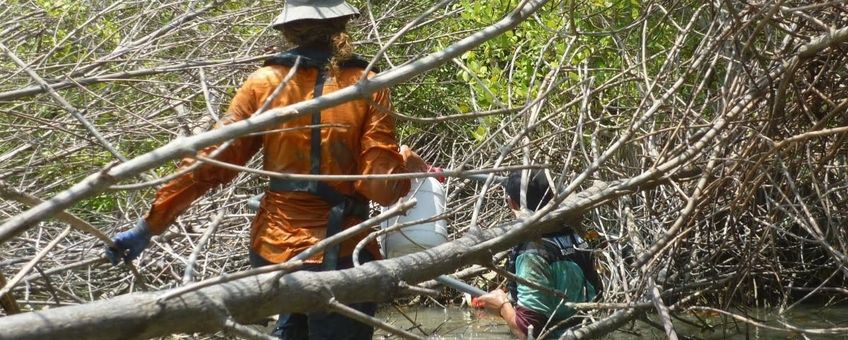
Sustainable protection of rapidly subsiding coastlines with mangroves
NIOZ Royal Netherlands Institute for Sea ResearchA Dutch-Indonesian team of scientists, jointly investigated the potential and limitation of mangrove restoration as a cost-effective and sustainable solution for coastal protection in rapidly subsiding areas. They have published their finding in Nature Sustainability.

Vulnerable coastlines
Unfortunately, precisely in these rural densely populated Asian regions, mangroves have in the past been cleared to free up land for other uses such as aquaculture. This has made these coasts vulnerable to rapid erosion. Restoring mangroves seems a logical solution to reverse this process and protect these densely populated coastlines. However, this requires understanding if mangroves can cope with extreme rates of relative sea level rises, as experienced in these subsiding areas.
Since 2015 NIOZ researcher Celine van Bijsterveldt visited Indonesia regularly during her studies and her Phd. “I saw how much the people suffered from coastal erosion and frequent inundation,” Van Bijsterveldt says. “To be able to answer if mangroves can help, I started with obtaining reliable measurements of the subsidence rate. This is extremely complicated if you work so remote.”
Local land subsidence causes high relative sea level rise
“Typically, measuring subsidence requires expensive complicated equipment,“ says Van Bijsterveldt. “As such instruments are lacking in these remote areas, we developed two novel and low-cost methods to approximate relative sea-level rise. In the mangroves we measured the sea level rise by simple pressure gages, that are normally used to measure tides. And in the village we analyzed how often people increased the height of the floor and the roof of their houses. Doing so we demonstrate how twenty kilometres of rural coastline and its vegetated foreshore, neighboring a rapidly subsiding city, were experiencing alarming rate of sea level rise.” Surprisingly, villages experienced much higher rates of sea level rise than mangrove forests, with dramatic consequences for local communities.

Two ways local communities cope with high relative sea level rise
“By interviews, we learned that local communities may respond in two ways to the experienced sea level rise: fight (keep the water out by raising the house) or flight (move further land inward or elsewhere),” says Van Bijsterveldt. Flood-prone coastal communities may not always be able to move to higher grounds. Financial and/or social limitations, such as landownership and income source (for instance fisheries) may bind families to the coast.
Nature-based solutions make mangrove restoration possible
Mangroves offer coastal protection by preventing coastal erosion and attenuating waves moving to the coast. But such protection will only work if there is enough mangrove forest to do the job. Van Bijsterveldt's research discovered that mature mangroves showcased an extreme high level of tolerance to subsidence and the resulting experienced rapid sea level rise.
But an adequate supply of sediment needs to be available along the shore. “Unfortunately, the latter is not the case near Semarang,” says professor Helmi from Diponegoro University. “But this finding is very promising for many less fast subsiding rural areas along muddy coast, as we can find in Indonesia and many other places around the world”.
Outlook for strongly subsiding areas
Overall, the present study highlights the urgency of addressing land subsidence as a critical factor influencing coastal vulnerability. In areas where the experienced relative sea level rise caused by subsidence is not compensated by sufficient sediment supply, the mangroves' ability to stabilize the coastline will deteriorate. This will result in the gradual inland migration of the mangrove forest. Rural communities are left with little choice but to also retreat landward. In this respect, the present study offers a future perspective on the fate of global coastal communities under accelerated global sea level rise.
“This study provides a glimpse into the future for poor rural areas on the coast struggling with experienced accelerated sea level rise due to subsidence,” says professor Helmi from Diponegoro University. “By showing the intricate dynamics between mangroves and their environment, Van Bijsterveldt’s findings contribute to develop effective strategies for mitigating the impacts of these pressing issues.”
International and interdisciplinary collaboration
“This glimpse in the future has been possible because of the unique international and interdisciplinary collaboration,” says professor Tjeerd Bouma from NIOZ and Utrecht University. “Only by bringing together ecologists, coastal physicists and sociologists from Indonesia and the Netherlands, it was possible to get an integrated perspective on the whole coast. We are also grateful for the active support of NGO’s and companies willing to invest in development of critical knowledge for climate proofing our coasts.”
This research project is part of a collaboration of the Royal Netherlands Institute for Sea Research (NIOZ), Utrecht University, Wageningen University, Deltares, TU Delft, Wetlands International and the Indonesian Diponegoro University. The research was financed by NWO-domain Applied and Engineering Sciences (project# 14753), and co-financed by Boskalis Dredging and Marine experts, Van Oord Dredging and Marine Contractors bv, Deltares, Witteveen & Bos and Wetlands International.
More information
- The article Subsidence reveals potential impacts of future sea level rise on inhabited mangrove coasts by Celine Bijsterveldt and her fellow researchers is published in Nature Sustainability.
Text: NIOZ
Photos: Celine van Bijsterveldt (lead photo: Dutch and Indonesian scientists at work in mangroves); Silke Tas
